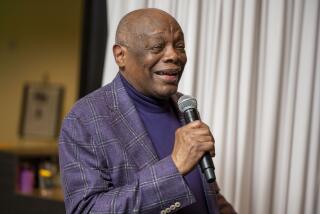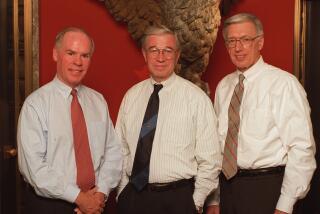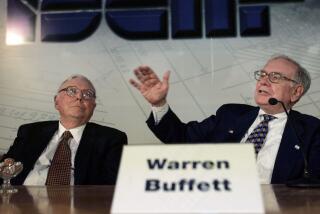Max Palevsky dies at 85; computer magnate and philanthropist
Reporting from Los Angeles
In certain well-connected circles, Max Palevsky was known as the billionaire patron of Los Angeles’ first black mayor, Tom Bradley.
But his portfolio resembled a conglomerate’s. A baron of the early computer industry, he helped found the world’s largest chipmaker, Intel. He came up with the cash to save a fledgling magazine called Rolling Stone and bankrolled movies. And he used his immense wealth to build notable art collections that turned the Los Angeles County Museum of Art into a destination for lovers of the Arts and Crafts movement.
Palevsky, 85, died Wednesday of heart failure at his Beverly Hills home, said his wife, Jodie Evans.
“I’m not sure the average person knows him,” said television producer Norman Lear, a longtime friend, “but anybody interested in the arts has Max to thank for the way he supported arts in this town … and, if you cared for his politics, for who he supported. He was a very unique soul.”
The noted art collector and philanthropist gained prominence in the 1960s when he turned Scientific Data Systems, a builder of mainframe computers, into a hugely lucrative business that he sold to Xerox in 1969 for $1 billion. He went on to serve as a director and chairman of Xerox’s executive committee before becoming a founder and director of Intel Corp.
He left the corporate world during the 1970s to produce movies, bolster the coffers of Rolling Stone and delve into politics.
He was an early supporter of George McGovern during his ill-fated 1972 presidential campaign, then ran Bradley’s successful 1973 bid for mayor. He also was a major backer of Robert F. Kennedy and Jimmy Carter during their presidential bids, and various campaigns of former Gov. Gray Davis. And, with Lear, he was a member of the “Malibu Mafia,” a loose alliance of extremely wealthy Westside Democrats who used their influence to promote liberal causes and candidates.
In later years, Palevsky soured on politics and concentrated more of his attention on art. He built important collections of Arts and Crafts movement furniture and Japanese woodblock prints, which have been featured in shows at LACMA.
He made a dramatic reentry into the political fray in 2000 when he wrote a $1-million check to the campaign finance reform initiative co-authored by Ron Unz, a conservative Silicon Valley tycoon.
The contribution — the largest political donation Palevsky had ever made — shocked state Democratic leaders, who opposed the ultimately unsuccessful measure. But Palevsky, saying that he was sickened by the “corruption of the electoral process,” announced that he made the contribution “in hopes that I will never again legally be allowed to write huge checks to California political candidates.”
Palevsky got his first taste of politics in the 1960s. In 1966, he supported Tom Braden, a newspaper publisher, for California’s lieutenant governor. In 1967, he was a regional leader of the antiwar group Business Executives Move for Vietnam Peace. Those experiences led to his involvement in Kennedy’s 1968 presidential campaign and the tumultuous Chicago Democratic National Convention, where he met McGovern.
“In some way, I guess, I tasted blood in the ’68 campaign. I really saw what it was all about,” he told the New York Times in 1972.
He jumped on the McGovern bandwagon before the South Dakota senator’s stunning upset in the Wisconsin primary. “Max was his most important early contributor,” said Frank Mankiewicz, McGovern’s campaign director.
According to “The Power and the Glitter,” a 1990 book about the interplay between Hollywood and Washington by former Los Angeles Times political writer Ronald Brownstein, Palevsky donated more than $319,000, which financed McGovern’s successful direct-mail operation. He also raised money from others, represented McGovern at a meeting with Vietcong negotiators in Paris, and advised him on issues.
He abruptly left McGovern’s side during the 1972 Democratic convention in Miami when he realized that his advice, particularly about the organization of the campaign, was being ignored.
“My role in the campaign wasn’t that significant,” he told The Times in 1973. “At a certain point I just found it all very boring and I just got up one day and said . . . ‘Son, I don’t see much point in staying around.’ ”
He did not stay out of politics for long, however. The following year he was the top advisor in then-Los Angeles City Councilman Bradley’s mayoral campaign. He made Gray Davis the campaign’s chief fundraiser, which launched Davis into politics. Bradley, who had lost his first bid for mayor to Sam Yorty in 1969, became the city’s first African American mayor in 1973. He was reelected four times, an unprecedented run that ended with his retirement in 1993.
The 1970s were a heady time for Palevsky, who had joined forces with the Malibu Mafia, a group so named because some of its members, such as Lear, lived in the exclusive Malibu Colony.
But by the end of the decade, he was withdrawing from politics and turning his attention back to the business world. According to Brownstein, the reason was that changes in campaign finance laws were limiting the huge donations that gave clout to wealthy contributors like Palevsky.
Twenty years later, the computer baron-turned-political benefactor was still disenchanted with politics. But this time, his unhappiness stemmed from his conclusion that so-called fat cats, as he had been, had corrupted the political process. He became the biggest backer of Proposition 25, the initiative on the 2000 statewide ballot that sought to limit individual contributions, ban corporate donations and require overnight disclosure of any contributions over $1,000.
Palevsky’s massive support of Proposition 25 came a day after news reports that then-Gov. Davis, who had received $150,000 from Palevsky for his political ventures over the years, had launched an aggressive effort to defeat the initiative by soliciting contributions from business interests. But it was, perhaps, too late: The state Democratic Party countered with a $500,000 donation to the anti-Proposition 25 forces; voters a week later soundly defeated the measure.
Palevsky felt so strongly about campaign finance reform that for the first time in his life he raised money for a Republican, U.S. Sen. John McCain (R-Ariz.), who spoke out strongly on the issue during his 2000 candidacy for the Republican nomination for president.
The son of Polish Jewish immigrants, Palevsky was born July 24, 1924, and grew up in Chicago during the Depression. His father was a house painter and his mother a homemaker; neither spoke much English.
During World War II, he served as an electronics officer in the Army Air Forces. Afterward, he studied at the University of Chicago, where he majored in mathematics and philosophy. He earned his bachelor’s degree in 1948, then undertook postgraduate work at UC Berkeley and UCLA.
An expert in symbolic logic, he planned on an academic career. But Palevsky became fascinated by computers, which the public in the early 1950s considered science fiction. Palevsky saw the possibilities in the emerging technology and in 1951 left academia to stake his claim.
He worked in the computer division of Bendix Corp. and for Packard Bell before launching Scientific Data Systems with 11 other scientists in 1961. Over the next several years, sales for the company, which focused on an untapped market for small mainframe machines, soared.
He sold the Santa Monica-based company to Xerox in 1969, a time, he later joked, “when $1 billion meant something.” His 10% share meant he pocketed $100 million.
Palevsky, whose fortune later earned him a spot in the Forbes 400, went on to serve as chairman or chief executive of Xerox’s executive committee, Silicon Systems and Daisy Systems Corp. He was one of the first major investors in Intel.
By the time he sold Scientific Data Systems, he was already interested in politics. But as that passion waned, his commitment to art collecting deepened.
Palevsky amassed one of the world’s premier collections of the American Arts and Crafts movement, including numerous pieces by Gustav Stickley.
In 1990, he gave 32 pieces of Arts and Crafts furniture to the Los Angeles County Museum of Art; three years later, he added an additional 42 pieces to his gift. In 2000, he donated $2 million to LACMA for Arts and Crafts works. He supplied about a third of the 300 objects displayed in a 2004-05 LACMA exhibit, “The Arts and Crafts Movement in Europe and America: 1880-1920.” Last year, the museum presented “The Arts and Crafts Movement: Masterworks From the Max Palevsky and Jodie Evans Collection.”
His Japanese prints included many works by 18th century masters Katsushika Hokusai and Kitagawa Utamaro. Palevsky loaned 44 of the 50 prints in his tightly monitored collection to LACMA for a show in 2001.
His passion for art embroiled Palevsky in controversy in the 1980s when he withdrew a $1-million pledge to help build a permanent downtown home for the Los Angeles Museum of Contemporary Art.
Claiming that the then-fledgling museum reneged on a promise to give him architectural control of its new complex on Bunker Hill, he filed a lawsuit in 1984 to recoup $500,000 he had already given the museum and excuse himself from paying the other half million.
The museum ultimately settled the dispute with “an amount exceeding the sum [$500,000] paid to the museum,” but less than the total amount he had originally pledged. He subsequently promised his art holdings to LACMA.
He could be unpleasantly controlling and admitted as much during an interview with The Times a few years ago.
When a reporter observed how he could not set down a book without carefully aligning its edges with the sides of a table, or how he meticulously arrayed six pairs of eyeglasses in a row next to six different decorative cases, Palevsky, who married and divorced five times, acknowledged, “I know it’s all a little obsessive. I should have been an architect.”
In addition to Evans, he leaves a daughter, Madeleine Moskowitz; four sons, Nicholas, Alexander, Jonathan and Matthew; a stepson, Jan Krajewski III; a sister, Helen Futterman; and four grandchildren.
In his last years, he increased his philanthropic efforts, giving $20 million in 2000 to his alma mater, the University of Chicago.
He professed little involvement in business affairs, having turned over the management of his finances to others. The man who had played a major role in creating today’s computer-obsessed society also confessed that he no longer had much interest in technology. In fact, he had begun to disparage the revolution he helped spawn, believing that computers and the Internet had become “substitutes for interaction with the real world.”
“I haven’t touched a computer, watched TV or used a credit card in 15 years. I am,” he told the Times in 2001, “a Luddite.”
More to Read
Start your day right
Sign up for Essential California for the L.A. Times biggest news, features and recommendations in your inbox six days a week.
You may occasionally receive promotional content from the Los Angeles Times.







